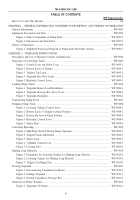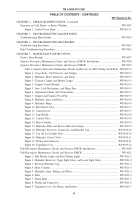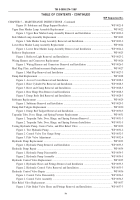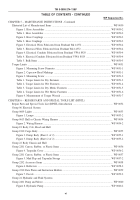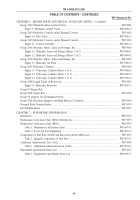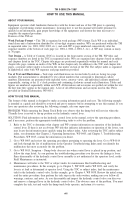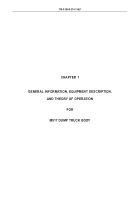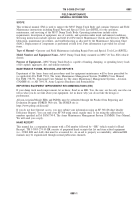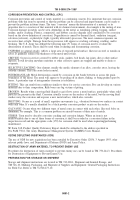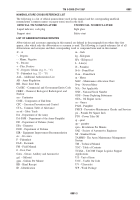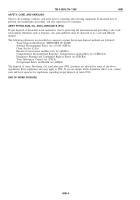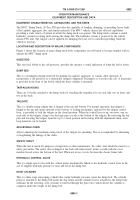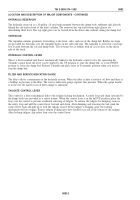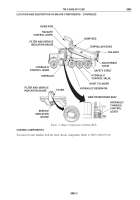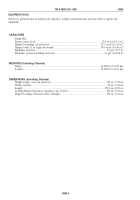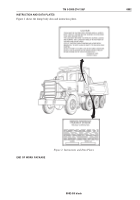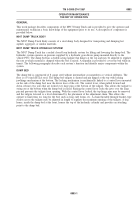TM-5-3805-274-13-P - Page 20 of 364
CORROSION PREVENTION AND CONTROL (CPC)
Corrosion prevention and control of Army materiel is a continuing concern. It is important that any corrosion
problems with this item be reported so that the problem can be corrected and improvements can be made to
prevent the problem in future items. The term “corrosion” means the deterioration of a material or its
properties due to a reaction of that material with its chemical environment. An example is the rusting of iron.
Corrosion damage in metals can be seen, depending on the metal, as tarnishing, pitting, fogging, surface
residue, and/or cracking. Plastics, composites, and rubbers can also degrade (also considered to be corrosion
based on the above definition of corrosion). Degradation is caused by thermal (heat), oxidation (oxygen),
solvation (solvents), or photolytic (light, typically ultraviolet) processes. The most common exposures are
excessive heat or light. Damage from these processes will appear as cracking, softening, swelling, and/or
breaking. The U.S. Army has defined the following nine (9) forms of corrosion used to evaluate the
deterioration of metals. These shall be used when evaluating and documenting corrosion.
UNIFORM (or general attack): Affects a large area of exposed metal surface, like rust on steel or tarnish on
silver. It gradually reduces the thickness of the metal until it fails.
CREVICE: Occurs in crevices created by rubber seals, gaskets, bolt heads, lap joints, dirt or other surface
deposits. It will develop anywhere moisture or other corrosive agents are trapped and unable to drain or
evaporate.
SELECTIVE LEACHING: One element, usually the anodic element of an alloy, corrodes away, leaving the
cathodic element. This can create holes in metal.
INTERGRANULAR: Metal deterioration caused by corrosion on the bonds between or across the grain
boundaries of the metal. The metal will appear to be peeling off in sheets, flaking, or being pushed apart by
layers. A particular type of intergranular corrosion is exfoliation.
PITTING: This can result from conditions similar to those for crevice corrosion. Pits can develop on various
materials due to their composition. Rifle boxes are big victims of pitting.
EROSION: Results when a moving fluid (liquid or gas) flows across a metal surface, particularly when solid
particles are present in the fluid. Corrosion actually occurs on the surface of the metal, but the moving fluid
washes away the corrosion and exposes a new metal surface, which also corrodes.
FRETTING: Occurs as a result of small, repetitive movements (e.g., vibration) between two surfaces in contact
with each other. It’s usually identified by a black powder corrosion product or pits on the surface.
GALVANIC: Occurs when two different types of metal come in contact with each other, like steel bolts on
aluminum, for example. This is a common problem on aircraft because of their mix of metals.
STRESS: Term used to describe corrosion cracking and corrosion fatigue. Where an item is not
ready/available due to one of these forms of corrosion, it shall be recorded as a corrosion failure in the
inspection record and the appropriate code (170) for corrosion shall be used when requesting/performing
maintenance.
SF Form 368, Product Quality Deficiency Report should be submitted to the address specified in
DA PAM 750-8, The Army Maintenance Management System (TAMMS) Users Manual.
OZONE DEPLETING SUBSTANCES (ODS)
The use of ODS for new acquisitions has been curtailed by Executive Order 12856, 3 August 1993, other
relevant public laws, and Department of Defense (DOD) and Army Policy.
DESTRUCTION OF ARMY MATERIEL TO PREVENT ENEMY USE
Procedures for destruction of Army materiel to prevent enemy use can be found in TM 750-244-3, Procedures
for Destruction of Equipment to Prevent Enemy Use.
PREPARATION FOR STORAGE OR SHIPMENT
Storage and shipment instructions are located in TM 743-200-1, Shipment and Limited Storage, and
TM 746-10, Marking, Packaging, and Shipment of Supplies and Equipment: General Packaging Instructions
for Field Use. Refer to TM 9-2320-273-10.
TM 5-3805-274-13&P
0001
0001-2
Back to Top

